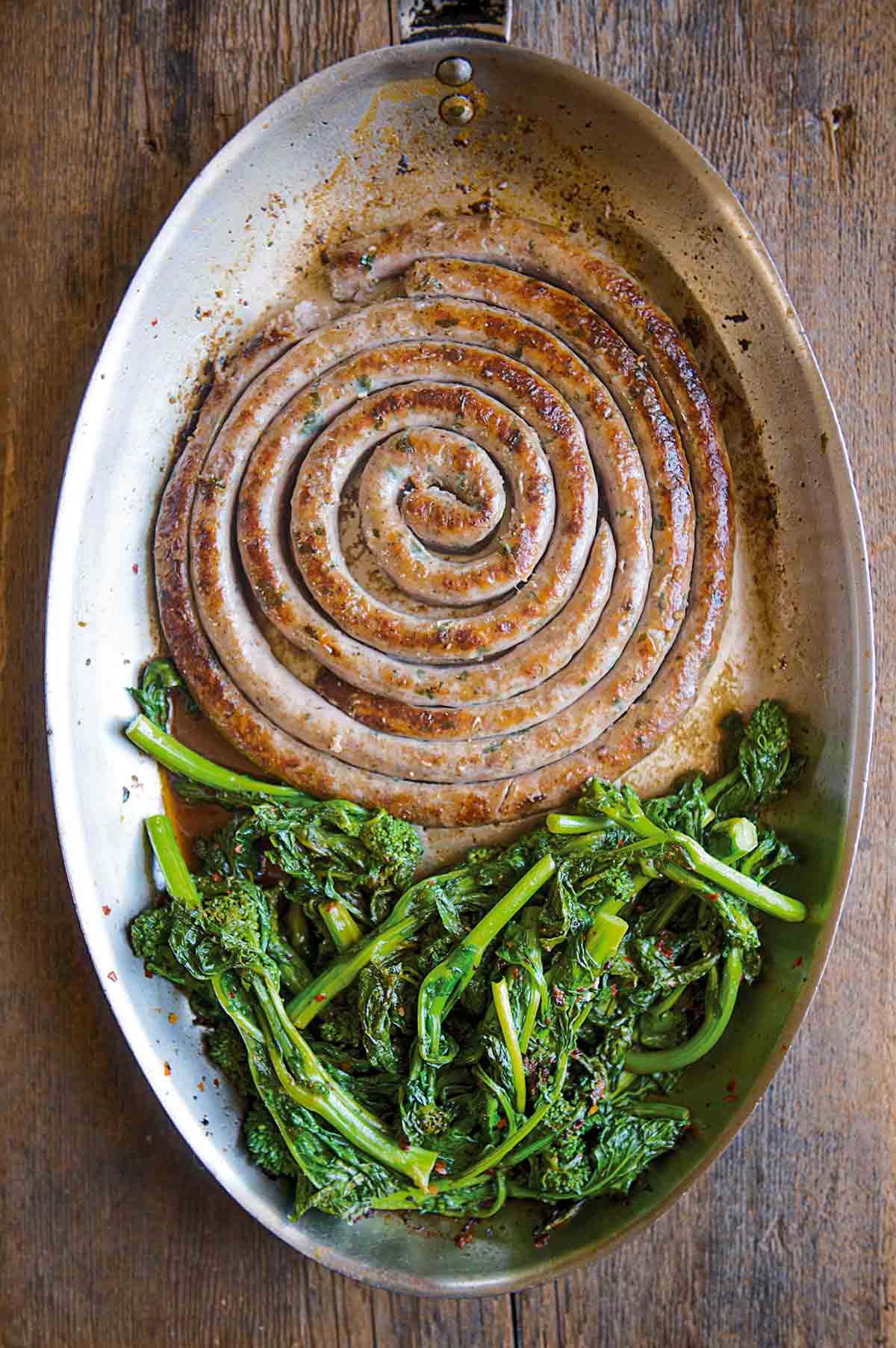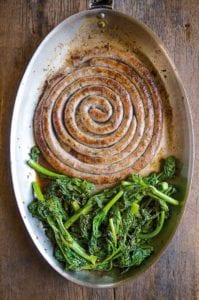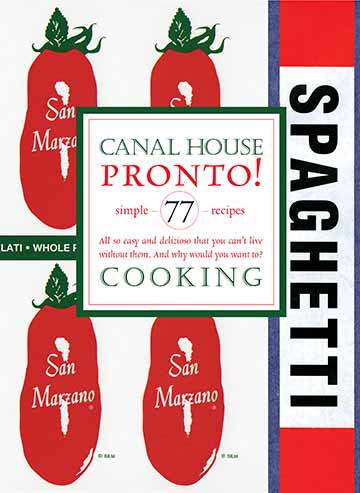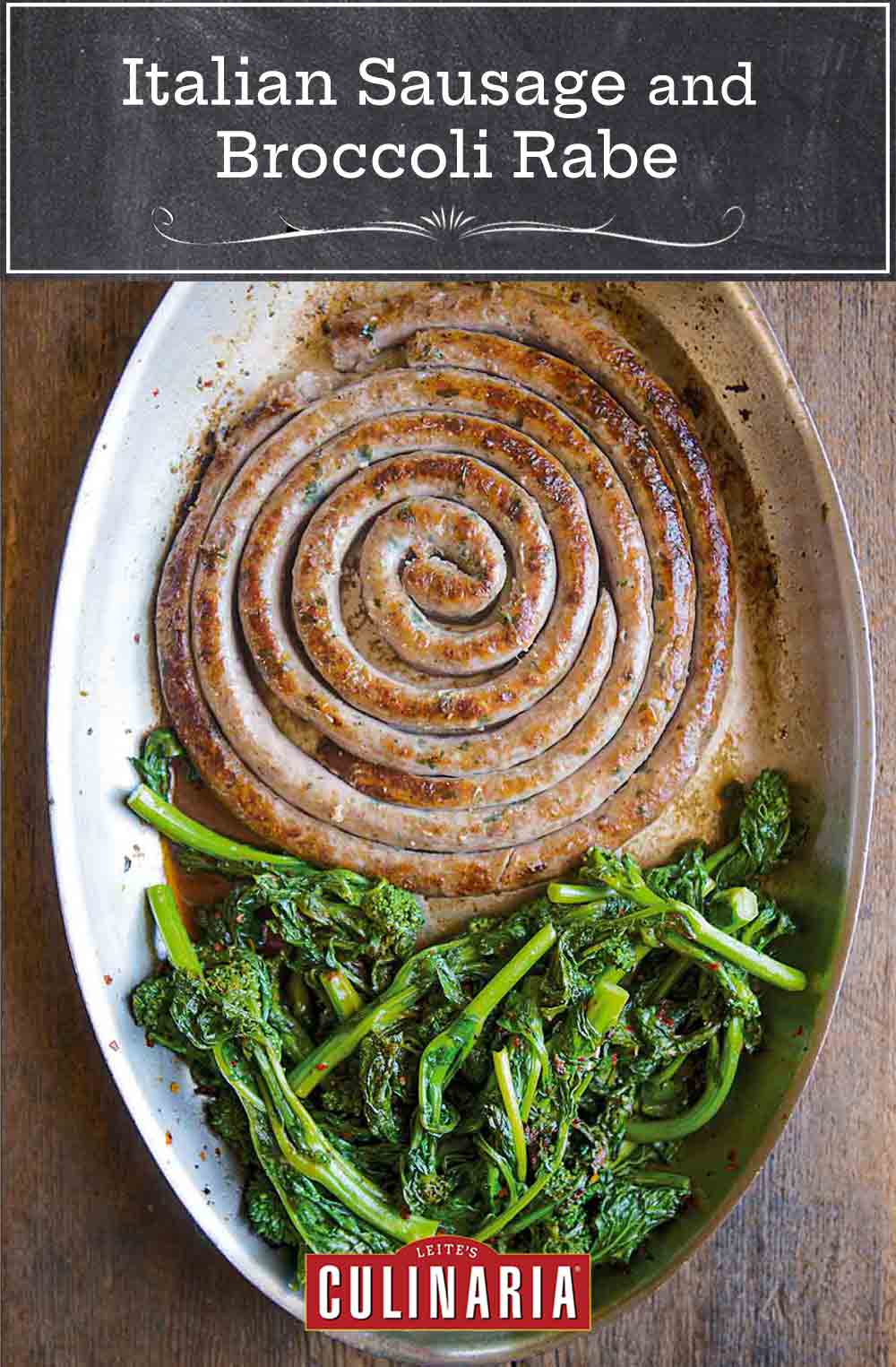
In this Italian sausage with broccoli rabe, as with most rustic Italian suppers, frugality and practicality come together in a spectacular yet simple collision of tastes that requires little fuss. It’s barely a recipe and more like a this blueprint for weeknight salvation.–Renee Schettler Rossi

Italian Sausage and Broccoli Rabe
Ingredients
For the Italian sausage
- One (1 1/2 to 2 pound) coil Italian sausage, (or substitute links)
- 2 tablespoons olive oil
- Scant 1/4 cup cold water, plus more as needed
For the broccoli rabe
- 1 bunch broccoli rabe* (rapini) or broccolini*, (see * below)
- 1/4 cup extra-virgin olive oil, plus more for drizzling
- 1 clove garlic, thinly sliced
- 1/4 to 1/2 teaspoon crushed red pepper flakes
- Salt, to taste
- 1/4 cup cold water
Instructions
Cook the Italian sausage
- Prick the sausage in a few places with the tip of a sharp knife to keep the casing from splitting as it cooks.
- Heat the olive oil in a heavy, large skillet over medium heat. Add the sausage and almost all of the water, cover, and cook until the sausage begins to brown on the bottom, about 15 minutes.
- Carefully turn the sausage over and, if the skillet is dry, add a splash more water. Cover and continue to cook until the sausage begins to brown on the other side, about 10 minutes.
- Uncover and keep cooking until the water evaporates and the sausage is well browned and cooked through, 5 to 10 minutes. (The sausage will brown quickly once the water evaporates. You can nudge the sausage a little here and there during cooking to be certain it doesn’t stick to the skillet.)
Cook the broccoli rabe
- Meanwhile, trim the thick stems from the broccoli rabe or Broccolini and discard or reserve for another use. Rinse the broccoli rabe or Broccolini and shake off any excess water.
- In a large skillet over medium heat, warm the extra-virgin olive oil. Add the garlic and red pepper flakes and cook just until fragrant, 1 to 2 minutes. Add the broccoli rabe or broccolini, a generous pinch salt, and the water, cover, and cook, turning the broccoli rabe or broccolini as it begins to wilt, until it’s tender but still bright green, about 5 minutes.
- Uncover and cook until the water evaporates, 3 to 5 minutes. Drizzle with oil and season to taste with salt.
Serve the Italian sausage and broccoli rabe
- Pile the sausage and broccoli rabe together, either moving everything to a skillet and taking that to the table or transferring everything to a platter. Serve warm. (Any leftovers work marvelously when chopped and tossed with freshly cooked pasta.)
Notes
*What You Need To Know About Broccoli Rabe
Broccoli rabe. Rapini. Broccoletti. Broccolini. Pretty much the same thing. Just a public service announcement in case you’re wondering “brocco-what?!” as you wander the produce aisles of your grocery store.
Explore More with AI
Nutrition
Nutrition information is automatically calculated, so should only be used as an approximation.
Recipe Testers’ Reviews
The cooking technique of this Italian sausage and broccoli rabe recipe takes me back to my roots. Braise in a little water, then fry. This is how I was taught to cook sausage, especially the thinner coils. The meat stays moist and you end up with a wonderful lacquer of the reduced cooking juices and olive oil, which deliciously glosses the ring.
Let me suggest that you serve this on some good Italian bread as a hero sandwich—yes, for dinner. A little mild bitterness from the greens and sausage love in every bite. Perfection.
A full 1/4 cup water may be a little too much, depending on how much moisture your sausage gives off in the first pass. I’d cut the amount of water in half and see where you are after 10 minutes. In my prep, I had so much liquid I had to uncover and rapidly cook some of it off to get any browning. Also, give your sausage a taste before salting the rapini. You might want to serve the veg without any salt if your sausage was produced with more then your palate prefers.
Coils of Italian sausage are my very favorite. In my family, we know them as Italian chivalade sausage, and we typically choose the “cheese and parsley” variation. Unlike larger links of the sweet Italian variety, this one has little to no fennel in the cure seasoning.
Italian sausage and broccoli rabe are a fit made in heaven, so when I saw this recipe, I had to try it out. I wasn’t able to get a coil of sausage, so I bought regular mild links with fennel. Usually I just fry them, but the method of cooking them in water first and then frying works great. I will do that from now on with sausage.
The recipe works very well as written and was very tasty. We had fried polenta with it. Will make it again.
This Italian sausage and broccoli rabe recipe, in my book, is more of a serving suggestion, as opposed to a recipe. However, the simplicity, ease, and flavor of this dish merits a TC.
I used 2 pounds locally made Italian sausage links and broccoli rabe; however, any assortment of greens will work just fine in this application. The bitterness of the greens complemented the spiciness of the sausage.
I felt it was missing some grains so I made some couscous to go with it. Perfect for a weeknight or any busy day.
This Italian sausage and broccoli rabe recipe was my first time trying broccoli rabe. (I had some trouble finding it at the store ’till I found it also goes by the name rapini.) The recipe comes together easily and doesn’t need much monitoring. I found that it’s important to make sure the skillet doesn’t run dry while cooking the sausage. The one thing I would change would be to add a little more garlic.
How kind of the author to provide a great side dish to one of my favorite breakfast items! I buy Italian sausage coil (a.k.a. Barese sausage) on a regular basis. My pet name for it is “meat record,” because that’s basically what it looks like—a record made out of meat.
The quality of the sausage is what will really make this simple meal sing. The savory flavors present in the sausage offset the slightly bitter greens in a really good way. It really is timeless, and is as good for breakfast as it is for lunch or dinner.
And it’s quick to prepare, from start to table, which means it’s quite doable for any morning or evening weeknight meal. I find it hard to brown anything while there is still water in the pan. In order to brown my sausage, I had to wait until the water was gone for both sides. I didn’t work too hard removing all the tough-ish stems from the rapini. I just cut the base stem at the point where the leaves began to branch out. It worked fine. Fresh, buttered Italian rolls is a nice way to round out the meal and to mop up any pan juices that remain—it’s almost obligatory! Adding a bit of truffled salt to the broccoli gives a little more depth to the flavor. Usually I add a splash of my favorite hot mustard to my plate when I serve the sausage. Both touches are unnecessary, but can lend some variety if desired.
I learned a lot today—Broccolini and broccoletti are the same thing. Duh! For this Italian sausage and broccoli rabe recipe, I used what they call broccoletti here and the next time (yes, there will be many next times!) I will chase down broccoli rabe. I
also used a locally made Italian sausage that was not coiled, and while it would have looked so much more “photo-worthy” if I had found a coil, the taste was heavenly as it was! This recipe is straightforward and easy peasy. I found that actually using the times suggested worked better than my usual guessing. Lesson learned—and a very handy one, at that!
I was not sure about trimming the stems—cut them off, or trim them into slim same size stalks? I chose the latter because it looked better, and I like broccoli stems. It worked well, and it was quite nice-looking to have those slender trimmed stalks snuggled up against the sausages.
I really wanted to make this Italian sausage and broccoli rabe recipe, but I couldn’t find a coil of Italian sausage, so I decided to try it using grocery-store Italian sausage links. For such a simple recipe, this packs a lot of flavor.
I tried it with the broccoli rabe, but think this would work equally well with a number of vegetables to fit your taste. Next time, I think I’ll cook the sausage and broccoli together and deglaze the skillet with a little wine. We loved the leftovers, too; I tossed the sausage and some pasta in a pan with olive oil to reheat, adding Parmesan cheese. I let the pasta get a little crisp—wonderful. Both versions got high ratings, and everyone was wishing there was more they could take for lunch. A simple recipe that’s easy to customize.
This Italian sausage and broccoli rabe recipe was full of flavor and serving it family-style stirred memories of many Saints’ Day street festivals, where the same aroma was in the air. I would like to try it with chicken sausage and seafood sausage with just a splash of white balsamic vinegar to bring out all the flavor notes.
















Anyone know where I can get a skillet just like the one in the picture above?
John, certainly. You can purchase the skillet here.
Thank you very much.
My pleasure, John.
My grandparents used to make this – I know I am not spelling it right, but the sausage was called chevrelat. They used to toss it on the grill too in the summer. Such good memories.
Lovely, Rachel! Curious about the chevrelat sausage and going to research that a little. We so appreciate you sharing this with us. Amazing how food can instantly flood us with memories, yes?
I have been looking for a recipe for Italian Chivalade sausage…I make sausage at home and I am interested in making this. In reading, I understand it is ground lamb and it is in. 22 MM casing. Do you have a recipe for this or do you know who may have a have one? Thank You for your time.
Regards, Vince Tripi
Hi Vincent, we’ve reached out to several people to see if we can get you an exact recipe. In the meantime, one of our testers had this advice. “When he was a young boy, my husband made chivalade sausage all the time in his father’s butcher shop. It is simply a combination of chopped pork and lamb (with chopped veal added sometimes), grated percorino or parmigiano cheese, salt, pepper and chopped parsley. Unfortunately, he doesn’t have a recipe with measurements since they made it in bulk quantities, but those are the correct ingredients. Also, this type of sausage is made using narrow casings, usually lamb.”
Beth, thanks for this. Vincent, I hope this helps you get closer to making your beloved sausage.
Hi Vincent, one of our testers, Dawn English, researched your question and located a recipe. This from Chef Rosemarie A. Drygala who grew up in the Italian Food Business;
Chivalade
Small size sheep sausage casings (not hog )
5 pounds pork butts or ground pork, medium grind, ground while very cold
1 cup finely chopped Italian parsley
1 cup imported Romano or Loccatelli hard cheese, finely chopped
Salt, course black pepper and granulated garlic to taste . Check spices by cooking a small patty for taste
A drizzle of ice water for ease of stuffing
Let us know if you give it a try.